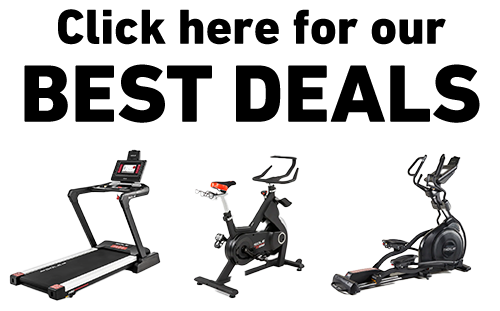Key Takeaways
- AMRAP pushes you to complete as many rounds as possible in a set time. It's great for building work capacity and mental toughness.
- EMOM workouts have you perform exercises every minute on the minute, perfect for consistency and recovery management.
- Tabata uses 20 seconds of work with 10 seconds of rest, repeated 8 times for maximum intensity in just 4 minutes.
- Each method offers unique benefits: AMRAP builds endurance, EMOM develops skills, and Tabata improves VO2 max.
- SOLE's versatile equipment lineup, from sprint-ready treadmills to quick-adjust dumbbells elevates these time-based training methods.
What are AMRAP, EMOM & Tabata?
Time-based training shifts focus from counting reps to maximizing quality work within time limits. This creates clear ways to measure improvement, makes workouts more efficient, and adds competition that drives performance. These methods also add variety and prevent the boredom that leads to plateaus.
AMRAP: As Many Rounds As Possible
AMRAP means "As Many Rounds As Possible." You complete as many cycles of exercises as you can in a set time. Most AMRAPs last 5 to 30 minutes, with 10 to 20 minutes being most common. The goal is simple but tough: do as much work as possible while keeping good form.
What makes AMRAP work is that you set your own pace. You decide when to work and when to rest, creating an intuitive approach to intervals. The clock becomes both your motivator and competitor, pushing you to do more than you would with regular sets and reps.
EMOM: Every Minute On the Minute
EMOM structures your workout into one-minute intervals. When each minute starts, you do your prescribed exercises, then rest for whatever time is left before the next minute. This creates a built-in work-rest pattern. Finish faster, get more rest. Go slower, get less recovery time.
EMOM encourages good form and focused execution. Unlike AMRAP where you might rush, EMOM's structure promotes quality reps with clear recovery periods. This makes it great for learning new skills and strength work where bad form could hurt you.
Tabata: 20 Seconds Work, 10 Seconds Rest
Tabata is the most precise protocol. You work for 20 seconds at maximum intensity, rest for 10 seconds, and repeat for 8 rounds (4 minutes total). Dr. Izumi Tabata developed this while working with Olympic speed skaters. His research showed remarkable improvements in both aerobic and anaerobic capacity from this brief but brutal method.
True Tabata requires absolute maximum effort during work periods. The original protocol demands 170% of VO2 max effort, which is a level you simply can't maintain for long. That's why real Tabata workouts are so short yet effective.
Why These Formats Are Changing Fitness
These time-based methods make high-intensity work accessible, measurable, and efficient. They're perfect for busy schedules while delivering better results than traditional steady-state workouts. The clear structures remove guesswork, making them ideal for beginners and advanced athletes alike.
These formats create natural progression. As you get fitter, you complete more work at the same time. This self-adjusting difficulty keeps challenging you regardless of your level.
|
At SOLE, we're proud to offer the best exercise equipment for your home or gym. Our machines are built to meet the highest quality and performance standards, making them perfect for fitness enthusiasts at any level. SOLE Products
|
AMRAP Workouts: Building Work Capacity
AMRAP sessions show your true work capacity. Not just what you can do when fresh, but what you can sustain when tired.
How AMRAP Training Works
AMRAP structure is simple. Pick a series of exercises, set rep counts, start your timer, and complete as many rounds as possible before time runs out. Most AMRAPs last 10 to 20 minutes and include 3 to 5 exercises done in order.
Smart exercise selection creates natural rest within the workout. Pair push-ups (upper body) with squats (lower body) so your arms rest while your legs work. This rotation lets you work longer and do more total volume.
5 Benefits of AMRAP Training
- Cardiovascular conditioning - Keeps your heart rate up for extended periods
- Mental toughness - Pushes you through barriers when your body wants to quit
- Work capacity - Builds ability to sustain effort over time
- Calorie burn - Creates afterburn effect for 24–48 hours
- Progress tracking - Round count shows clear improvements
AMRAPs work great for busy people who need maximum results in minimal time. The flexible pacing suits all fitness levels. Those who like measurable progress find AMRAPs motivating as improvements show through increased rounds.
3 AMRAP Workout Examples
Beginner AMRAP (10 minutes)
- 5 Bodyweight Squats
- 5 Knee Push-ups
- 5 Glute Bridges
- 5 Bird Dogs (each side)
Focus on perfect form and rest as needed.
Intermediate AMRAP (15 minutes)
- 10 Dumbbell Thrusters
- 15 Kettlebell Swings
- 20 Mountain Climbers
- 5 Burpees
Keep moving with minimal breaks.
Advanced AMRAP (20 minutes)
- 15 Wallballs (20/14 lb)
- 12 Pull-ups
- 9 Push Press (95/65 lb)
- 24 Double-Unders
Push the pace while maintaining good form.
Start at a sustainable pace rather than sprinting. Track complete rounds plus how far you got in partial rounds. Repeat benchmark AMRAPs every 4 to 6 weeks to measure progress.
EMOM Training: Precision & Pacing
EMOM training balances intensity with precision through strict timing. When the clock hits zero, you start your work, complete it efficiently, then rest until the next minute.
The EMOM Framework
Basic EMOMs assign one exercise per minute, but many variations exist. Standard EMOMs last 10 to 30 minutes. "Death by" EMOMs add one rep each minute until you can't complete the work. Alternating EMOMs switch exercises on odd and even minutes for partial recovery.
The key to EMOM success is honest performance. Complete work with proper form rather than rushing through sloppy reps. As you get fitter, you'll naturally get more rest time, allowing you to increase work or weight.
Why EMOM Improves Recovery
EMOM's structured work and rest periods teach your body to recover quickly between efforts. Unlike continuous training, EMOMs help your heart and muscles rapidly shift between work and recovery. This adaptation helps in sports and real-world activities.
The precise timing also builds consistency. You learn to pace efforts and mentally prepare for the next round. This creates powerful training habits that transfer to other workouts.
Best EMOM Exercises
- Olympic lifts - Clean, snatch, jerk (technical work needs rest)
- Strength moves - Squats, deadlifts, presses
- Gymnastics - Pull-ups, dips, handstand work
- Power moves - Kettlebell swings, box jumps
- Conditioning - Rowing, biking, running (use distance/calories)
4 Sample EMOM Workouts
Beginner (10 minutes)
- Odd minutes: 10 air squats
- Even minutes: 5 push-ups
Intermediate (16 minutes)
- Minute 1: 15 kettlebell swings
- Minute 2: 10 push-ups
- Minute 3: 12 goblet squats
- Minute 4: 20 mountain climbers (Repeat 4 times)
Advanced Strength (20 minutes)
- Odd minutes: 12 dumbbell thrusters
- Even minutes: 15 calories on rower
Advanced Technical (20 minutes)
- Minute 1: 2 power cleans + 1 jerk
- Minute 2: 8 chest-to-bar pull-ups
- Minute 3: 10 front squats
- Minute 4: 12 burpees (Repeat 5 times)
Tabata Protocol: Maximum Results in 4 Minutes
Real Tabata follows precise rules established through research. Understanding the true protocol reveals why 4 minutes can deliver such amazing results.
The Original Research
In 1996, Dr. Izumi Tabata's team compared 60 minutes of moderate exercise with 4 minutes of high-intensity intervals. The 4-minute protocol produced better improvements in both cardiovascular and power fitness. This shocked the fitness world.
The key was intensity. Athletes worked at 170% of their VO2 max during 20-second intervals. This extreme effort becomes impossible after 6 to 8 rounds, explaining why true Tabata is both effective and brief.
The Exact Tabata Structure
Real Tabata follows this pattern without variation:
- 20 seconds all-out work at maximum intensity
- 10 seconds complete rest
- Repeat 8 times (4 minutes total)
No modifications, no extended rest, no reduced intensity. Even small changes reduce effectiveness. The 2:1 work-to-rest ratio optimizes development of both aerobic and anaerobic systems.
Why Tabata Works
Tabata stresses multiple energy systems at once. The 20-second max efforts deplete immediate energy stores and create lactate buildup. Brief rests prevent full recovery, forcing powerful adaptations. The oxygen deficit drives cardiovascular improvements.
Research shows true Tabata can increase VO2 max by 14% and anaerobic capacity by 28% in just 6 weeks. These dual improvements explain why Tabata transfers so well to sports and general fitness despite minimal time commitment.
3 Real Tabata Workouts
- Bike Tabata: Set high resistance on a stationary bike. Pedal at absolute maximum for 20 seconds, rest 10 seconds, repeat 8 times. Track watts or distance to measure performance.
- Burpee Tabata: Maximum-effort burpees for 20 seconds, rest 10 seconds, repeat 8 rounds. Count total reps across all rounds.
- Sprint Tabata: Sprint at maximum speed for 20 seconds, rest 10 seconds, repeat 8 times. Use a track or treadmill (careful with transitions).
Quick Comparison Table
|
Feature |
AMRAP |
EMOM |
Tabata |
|
Duration |
5–30 minutes |
10–30 minutes |
4 minutes |
|
Work/Rest Pattern |
Self-paced |
Work + rest = 1 minute |
20s work/10s rest |
|
Intensity Level |
Moderate to high |
Moderate |
Maximum (170% VO2 max) |
|
Best For |
Work capacity, endurance |
Skill development, strength |
VO2 max, power |
|
Recovery Needed |
24–48 hours |
12–24 hours |
48–72 hours |
|
Calorie Burn |
High total burn |
Moderate |
Highest per minute |
|
Beginner Friendly |
Yes (pace yourself) |
Yes |
No (too intense) |
|
Equipment Needed |
Minimal |
Varies |
Minimal |
Maximize Your AMRAP, EMOM & Tabata Training with SOLE Equipment
Now that you understand these powerful training methods, let's talk about equipment that makes them even more effective. While you can do bodyweight versions, having the right tools transforms these workouts from good to exceptional.
SOLE's versatile equipment lineup gives you everything needed to master all three training styles.
For Tabata protocols, SOLE's cardio equipment shines. The F63, F80, F85, F89, TT8, and ST90 handles those brutal 20-second sprints perfectly. The powerful motor maintains speed even during max efforts, while the Cushion Flex Whisper Deck reduces joint impact by 40%.
Try Tabata on the SR500 Rower for full-body intensity that'll leave you gasping in just 4 minutes. The built-in monitors track your intervals precisely, ensuring you hit that crucial 20/10 timing.
Your AMRAP and EMOM sessions get a massive upgrade with the SW180 Adjustable Dumbbells. Quick weight changes between exercises keep your heart rate up during AMRAPs, while the precise loading options (5–80 pounds) let you nail the perfect weight for EMOM strength work. Pair them with the SW116 Weight Bench for even more exercise variety—crucial for those longer AMRAP sessions.
The SOLE+ app brings it all together with timer features and guided workouts specifically designed for interval training. No more fumbling with separate timer apps while trying to count rounds.
Frequently Asked Questions (FAQ)
Can beginners do these workouts?
Yes, for AMRAP and EMOM with appropriate exercises and intensity. No, for true Tabata because it's too intense for beginners. Start with "Tabata-style" workouts at lower intensity.
Which burns the most calories in 30 minutes?
For a full 30-minute session, AMRAP wins due to continuous work. But minute-for-minute, Tabata burns more. For best fat loss, combine all three methods.
How often should I use these methods?
For optimal results, you should incorporate EMOM 3–4 times weekly, AMRAP 2–3 times weekly, and Tabata 1–2 times weekly when performed at true high intensity.
Can I combine formats in one workout?
Yes, but strategically. Try EMOM for strength work, then finish with a short AMRAP. Don't do true Tabata after other intense work.
Which SOLE equipment works best for AMRAP, EMOM, and Tabata workouts?
It really depends on which method you're doing and your fitness goals. For Tabata, you want equipment that can handle those all-out 20-second bursts.
The SOLE treadmills are perfect for sprint Tabatas because the Cushion Flex deck is a lifesaver when you're pushing max speed. The SR500 Rower is a personal favorite for Tabata because it hits your entire body and the monitor tracks your intervals perfectly. Some people love the exercise bikes for Tabata too since you can crank up resistance without worrying about flying off like on a treadmill!
For AMRAP and EMOM workouts, the SW180 or SW155 Adjustable Dumbbells are absolute game-changers.




Leave a comment
This site is protected by hCaptcha and the hCaptcha Privacy Policy and Terms of Service apply.